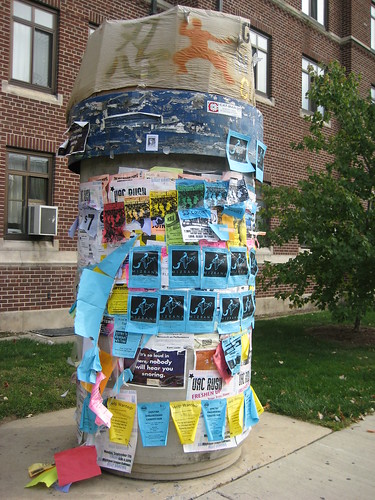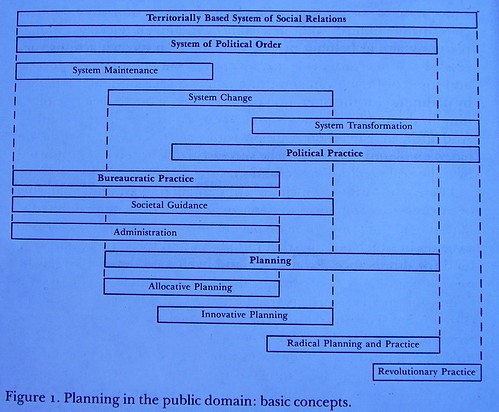 Flickr photo by Tony Hoffman in Ann Arbor, Michigan.
Flickr photo by Tony Hoffman in Ann Arbor, Michigan.The university I went to had a steam heating system and air ducts for the tunnel system, called kiosks, ended up being used for postering, providing a community bulletin board system. In other cities, such as Seattle, utility poles end up providing a similar function. Same with independently owned coffee shops, sometimes grocery stores, etc.
As printed community newspapers wane, another source of communicating falls off. People claim that the digital world--listservs, blogs, Facebook, email, etc.--suffice, but this waxes and wanes and in any case, the real point is that to maximize your messaging you have to be "omnichannel."
I have discussed elements of these issues here:
-- Community cleanups (and other activities) as community building and civic engagement activities
-- Ground up (guerrilla) art #2: community halls and music (among other things)
-- The ongoing tragedy of dying print media, the latest being community newspapers in Montgomery and Prince George's Counties, Maryland
From "Community cleanups (and other activities) as community building and civic engagement activities":
The basic point is to think about communities as networks of assets--physical, people, organizational--and how to use these broad concepts to reposition and rethink our approaches to neighborhood mobility and placemaking.
The other way I am thinking is more broadly about public spaces, public engagement, and ways of connecting in spaces. I'm not likely to go too far in this direction, because I am still mulling over the various aspects of the issue, plus it's probably off topic in terms of "improving neighborhood walkability."
The other way I am thinking is more broadly about public spaces, public engagement, and ways of connecting in spaces. I'm not likely to go too far in this direction, because I am still mulling over the various aspects of the issue, plus it's probably off topic in terms of "improving neighborhood walkability."
I mentioned probably that I have been engaging in an ongoing discussion with a grad student at York College in Toronto about what I think of as planning for spaces for connection and contestation, not unlike some of the issues involved in say protest in Tahrir Square (which I have been meaning to blog about for some time) or the Wisconsin State Capitol, or even a place to put up a protest sign.
I am thinking along this kind of framework, from the personal to the group, but somehow the other dimension of support/expression vs. opposition and resistance needs to be incorporated:
- individual expression (graffiti, letter to editor, social media))
- group/community (block party, mural, neighborhood parks, street fairs, community media, smart mobs, pirate radio, etc.)
- public assembly (Hyde Park type speakers corners, public squares in cities, college campues, etc.)
- resistance (oppositional, including suicide bombings in public space/transit infrastructure, what the IRA did in their London bombing campaign, wilding, riots, also celebrations, i.e., college sports related, that get out of hand, etc.).
I need to sit down and read lots of John Friedmann plus the scads of journal articles I've printed off on the topic, in order to come up with a master framework.
Basic Concepts, Planning in the Public Domain.
But while we can get pretty high falutin' about the topic, there are some real practical dimensions, such as:
1. Planning for community bulletin boards and community media -- providing space for such in commercial spaces, but also in civic places, e.g., bulletin boards in parks, libraries, etc., and do you have to get permission to post things?
2. Planning for community spaces in libraries and recreation centers, for meetings (yes we do that already), but what about spaces for community organizations located in libraries and other public buildings, bulletin boards sure, but how about galleries for local artists and other exhibitions, or spaces for regular exhibitions (that could rotate around the city) on community issues?
3. What about having some funds available, like what the Humanities Council of Washington does, for community curation projects, for projects on urban issues, etc., that can then be shown in such facilities?
4. Or something I've said for about 5+ years, that all libraries should have collections of materials specific to their communities. The Georgetown branch of the DC Public Library has the "Peabody Room" which is a focused collection on Georgetown. But all libraries could have a filing cabinet full of stuff and finding aids.
5. Public squares, pocket parks, etc., in neighborhood commercial districts. E.g., I will take some responsibility for failing to advocate for this in the H Street NE revitalization plan, or for not thinking of the need for an expanded public space around the 2nd and N Streets NE exit at the New York Avenue Metro station in NoMA.
Although I did recommend that the parking lot (and even the building) at the southeast corner of 12th and Newton Streets NE in Brookland could be converted into a small public square for the commercial district. 12th and Monroe would be best, but there really isn't the opportunity.
6. Having funds to support community festivals and events, even on a smaller scale.
7. And micro funds to support micro community projects. (Although ANCs do have some funds for this.)
8. Or how Arlington County government agencies exhibit in force at the Arlington County Fair. Or how some Baltimore City government agencies exhibit at Artscape.
Etc.
Etc.
I got a kick out of this one.
And I don't really understand the "McDrought" message.





Well the District loves them some street art. I've never been convinced they serve a higher purpose but they are "vibrant".
ReplyDeleteRE: protestors and urban design. Lots of stuff there, look at USAID democracy promotion. Baron Haussmann and the canons.
I've been mulling over the idea of externalities and cities and how the choke point create wealth -- basically interconnections. Anti-efficiency. And protest is certainly part of that.
the art of the street poster has vanished- it was once a big time practical art form that is now gone- like the rest of so many art forms- "replaced" by computers- which did nothing at all to really replace anything at all. Its all just gone and nobody seems to recognize the visual emptiness anymore
ReplyDelete